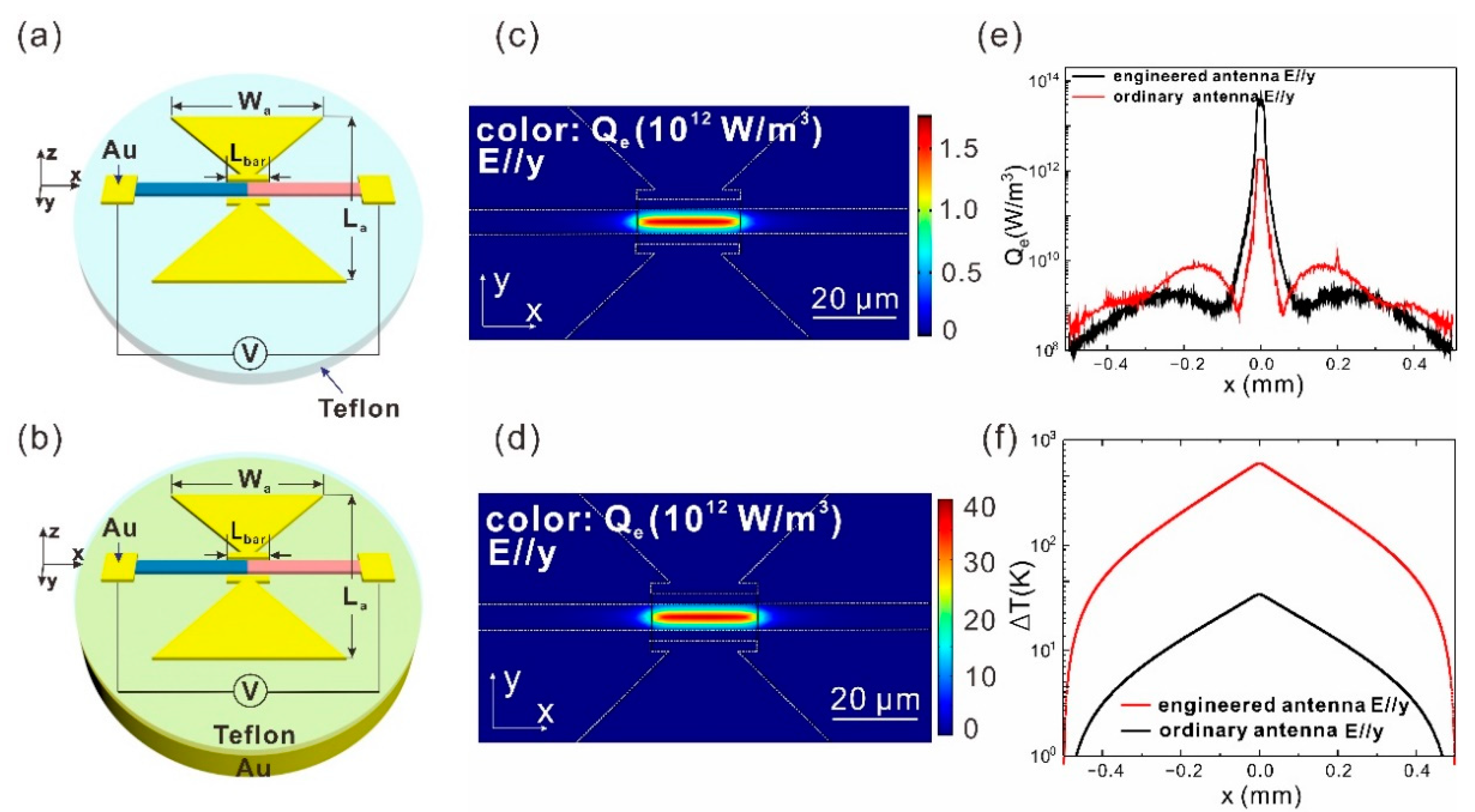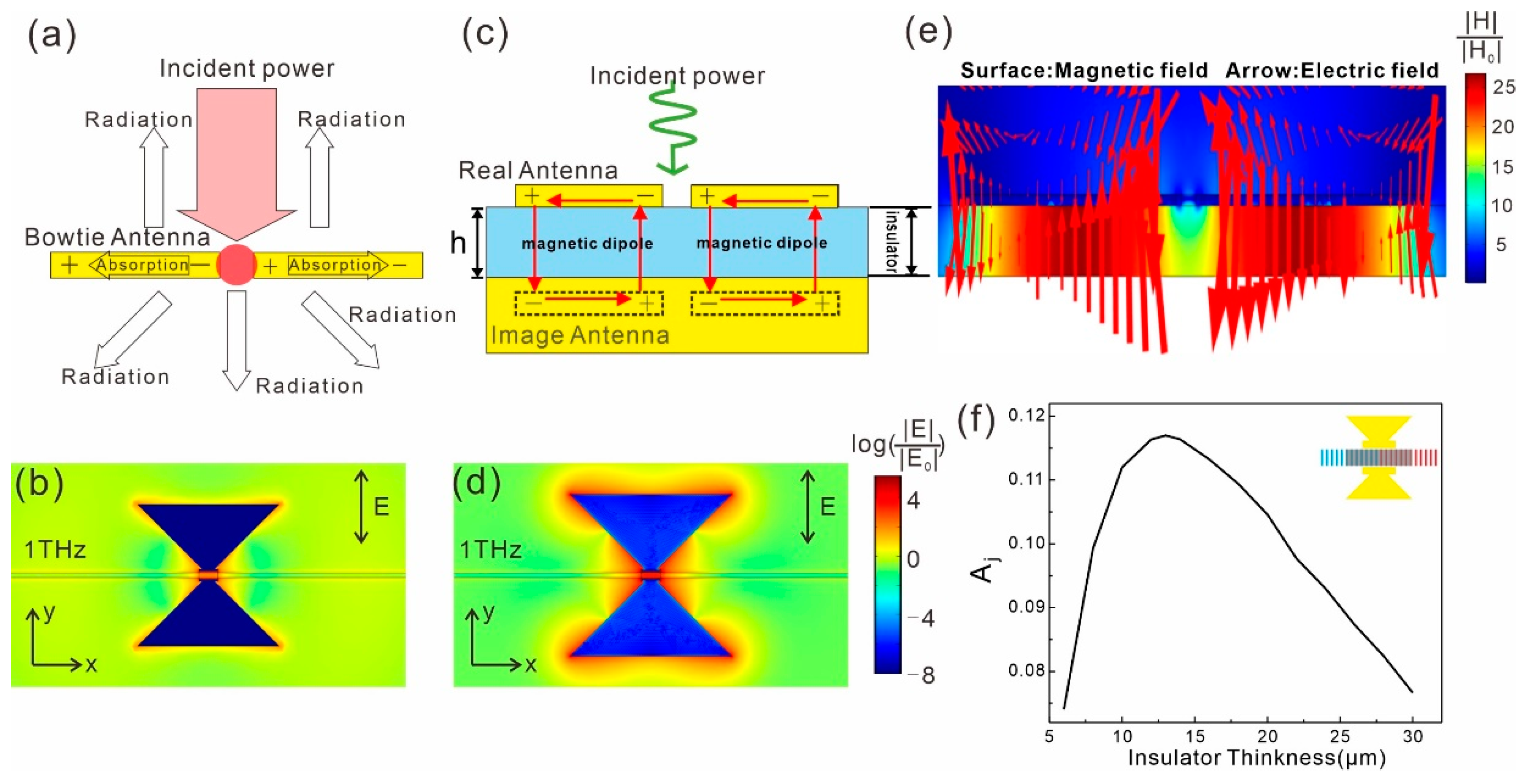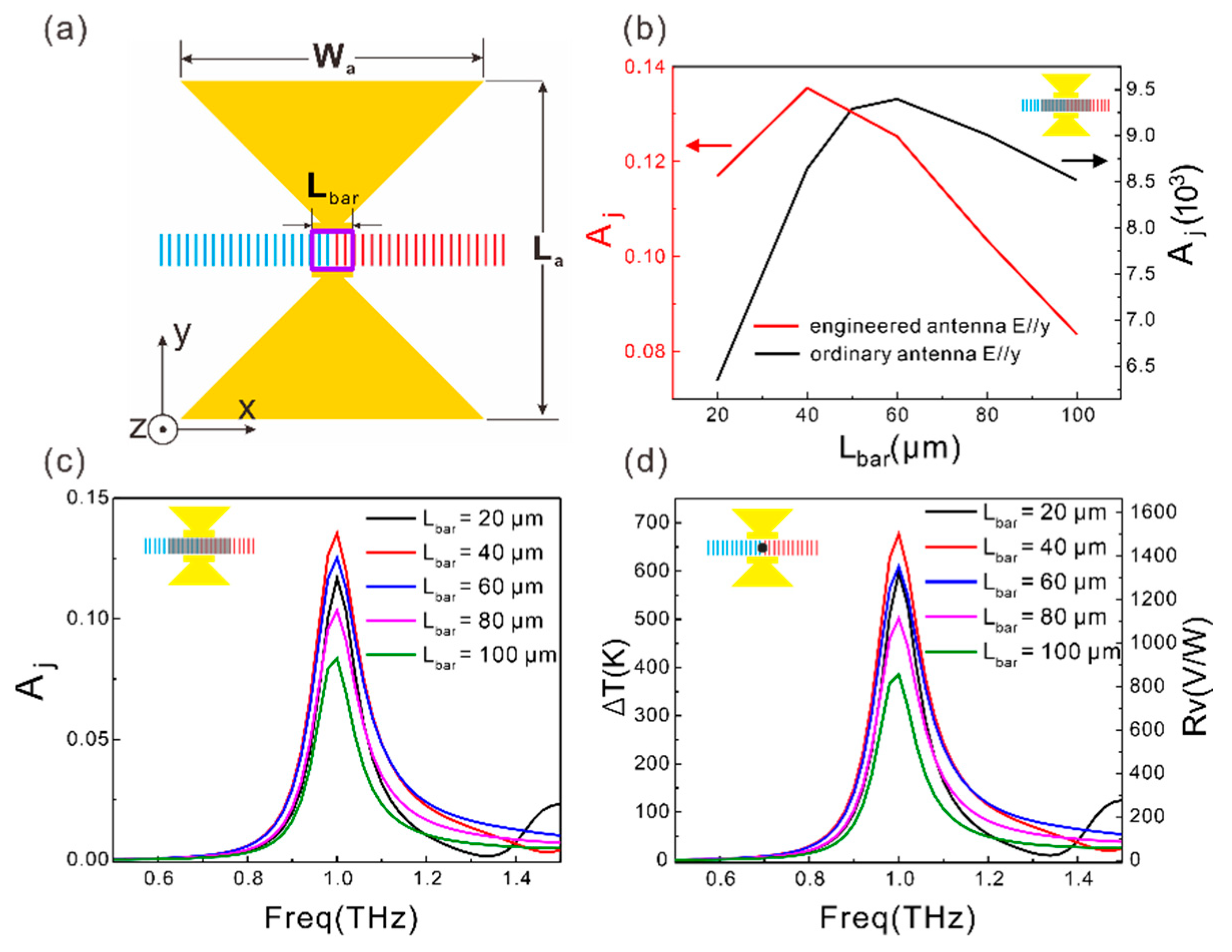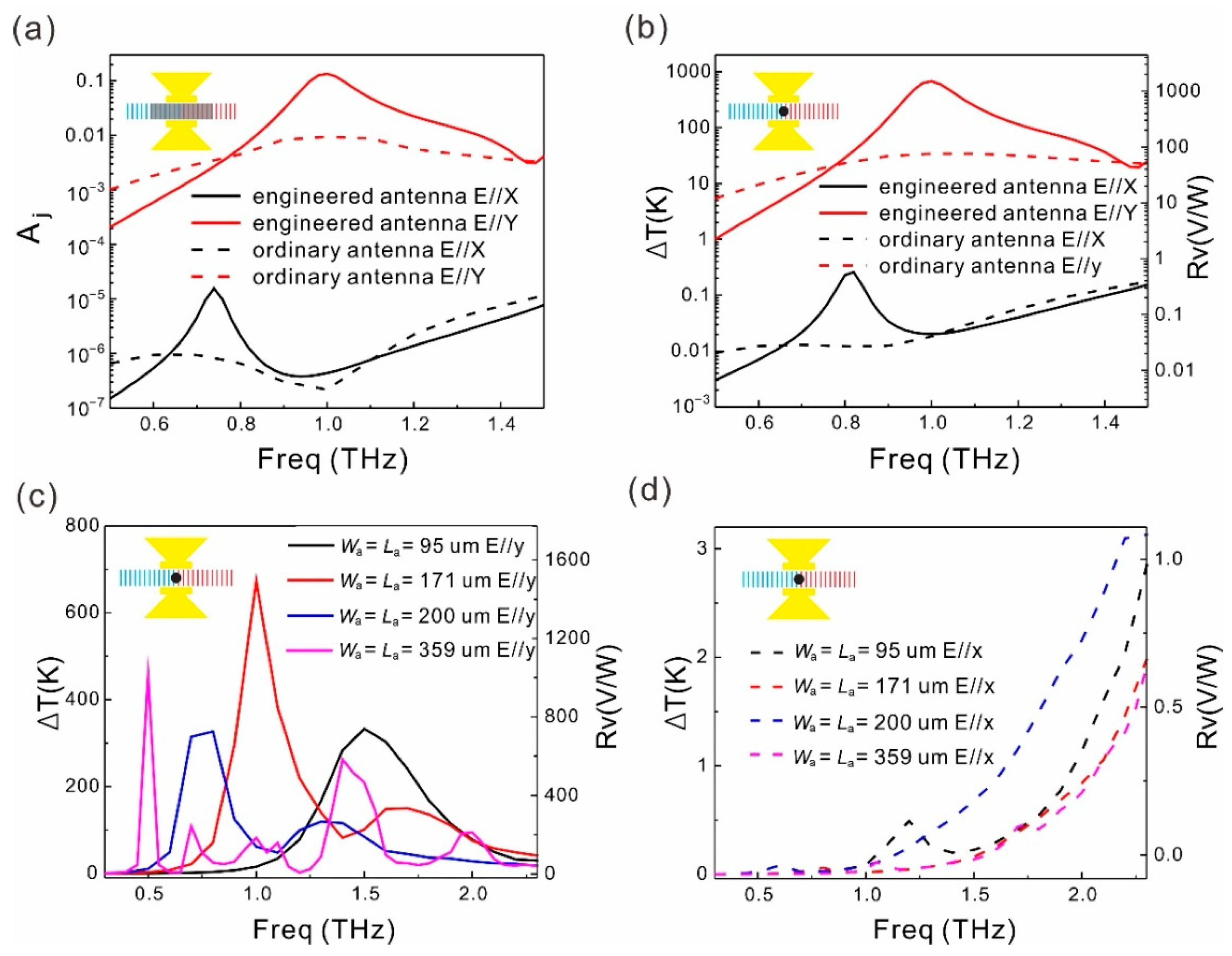Carbon Nanotube Far Infrared Detectors with High Responsivity and Superior Polarization Selectivity Based on Engineered Optical Antennas
Abstract
:1. Introduction
2. Materials and Methods
2.1. Aligned SWCNT Thin Film as an Effective Uniaxial Medium
2.2. Responsivity Obtained by Optical and Thermal Field Simulation
3. Results
4. Conclusions
Author Contributions
Funding
Institutional Review Board Statement
Informed Consent Statement
Acknowledgments
Conflicts of Interest
References
- Tonouchi, M. Cutting-edge terahertz technology. Nat. Photonics 2007, 1, 97–105. [Google Scholar] [CrossRef]
- Lee, M.; Wanke, M.C. Searching for a Solid-State Terahertz Technology. Science 2007, 316, 64–65. [Google Scholar] [CrossRef] [PubMed]
- Mittleman, D. Frontiers in terahertz sources and plasmonics. Nat. Photonics 2013, 7, 666–669. [Google Scholar] [CrossRef]
- He, X.; Léonard, F.; Kono, J. Uncooled Carbon Nanotube Photodetectors. Adv. Opt. Mater. 2015, 3, 989–1011. [Google Scholar] [CrossRef] [Green Version]
- Suen, J.Y.; Fan, K.; Montoya, J.; Bingham, C.; Stenger, V.; Sriram, S.; Padilla, W.J. Multifunctional metamaterial pyroelectric infrared detectors. Optica 2017, 4, 276–279. [Google Scholar] [CrossRef]
- Kulkarni, E.S.; Heussler, S.P.; Stier, A.V.; Martin-Fernandez, I.; Andersen, H.; Toh, C.T.; Özyilmaz, B. Exploiting the IR Transparency of Graphene for Fast Pyroelectric Infrared Detection. Adv. Opt. Mater. 2015, 3, 34–38. [Google Scholar] [CrossRef]
- Li, L.; Zhao, X.; Li, X.; Ren, B.; Xu, Q.; Liang, Z.; Di, W.; Yang, L.; Luo, H.; Shao, X.; et al. Scale Effects of Low-Dimensional Relaxor Ferroelectric Single Crystals and Their Application in Novel Pyroelectric Infrared Detectors. Adv. Mater. 2014, 26, 2580–2585. [Google Scholar] [CrossRef]
- St-Antoine, B.C.; Menard, D.; Martel, R. Single-Walled Carbon Nanotube Thermopile for Broadband Light Detection. Nano Lett. 2011, 11, 609–613. [Google Scholar] [CrossRef]
- Krause, B.; Bezugly, V.; Khavrus, V.; Ye, L.; Cuniberti, G.; Pötschke, P. Boron Doping of SWCNTs as a Way to Enhance the Thermoelectric Properties of Melt-Mixed Polypropylene/SWCNT Composites. Energies 2020, 13, 394. [Google Scholar] [CrossRef] [Green Version]
- Corletto, A.; Shapter, J.G. Discontinuous Dewetting, Template-Guided Self-Assembly, and Liquid Bridge-Transfer Printing of High-Resolution Single-Walled Carbon Nanotube Lines for Next-Generation Electrodes and Interconnects. ACS Appl. Nano Mater. 2020, 3, 8148–8160. [Google Scholar] [CrossRef]
- Cai, B.; Yin, H.; Huo, T.T.; Ma, J.; Di, Z.; Li, M.; Hu, N.; Yang, Z.; Zhang, Y.; Su, Y. Semiconducting single-walled carbon nanotube/graphene van der Waals junctions for highly sensitive all-carbon hybrid humidity sensors. J. Mater. Chem. C 2020, 8, 3386–3394. [Google Scholar] [CrossRef]
- Hadjichristov, G.B.; Exner, G.K.; Marinov, Y.G.; Vlakhov, T.E. Photo-electrical response of nanocomposites from single-walled carbon nanotubes incorporated in tris(keto-hydrozone) discotic mesogen. J. Phys. Conf. Ser. 2021, 1762, 012011. [Google Scholar] [CrossRef]
- He, X.; Fujimura, N.; Lloyd, J.M.; Erickson, K.J.; Talin, A.A.; Zhang, Q.; Gao, W.; Jiang, Q.; Kawano, Y.; Hauge, R.H.; et al. Carbon Nanotube Terahertz Detector. Nano Lett. 2014, 14, 3953–3958. [Google Scholar] [CrossRef]
- He, X.; Wang, X.; Nanot, S.; Cong, K.; Jiang, Q.; Kane, A.A.; Goldsmith, J.E.M.; Hauge, R.H.; Léonard, F.; Kono, J. Photothermoelectric p–n Junction Photodetector with Intrinsic Broadband Polarimetry Based on Macroscopic Carbon Nanotube Films. ACS Nano 2013, 7, 7271–7277. [Google Scholar] [CrossRef]
- Agio, M.; Alù, A. Optical Antennas; Cambridge University Press: Cambridge, UK, 2013. [Google Scholar]
- Novotny, L.; Van Hulst, N. Antennas for light. Nat. Photonics 2011, 5, 83–90. [Google Scholar] [CrossRef]
- Giannini, V.; Fernandez-Dominguez, A.I.; Heck, S.C.; Maier, S. Plasmonic Nanoantennas: Fundamentals and Their Use in Controlling the Radiative Properties of Nanoemitters. Chem. Rev. 2011, 111, 3888–3912. [Google Scholar] [CrossRef]
- Chen, B.; Ji, Z.; Zhou, J.; Yu, Y.; Dai, X.; Lan, M.; Bu, Y.; Zhu, T.; Li, Z.; Hao, J.; et al. Highly polarization-sensitive far infrared detector based on an optical antenna integrated aligned carbon nanotube film. Nanoscale 2020, 12, 11808–11817. [Google Scholar] [CrossRef] [PubMed]
- Sihvola, A.H. Electromagnetic Mixing Formulas and Applications; Institution of Electrical Engineers: London, UK, 1999. [Google Scholar]
- Han, J.; Zhu, Z.; Liao, Y.; Wang, Z.; Yu, L.; Zhang, W.; Sun, L.; Wang, T. Optical conductivity of single walled nanotube films in the Terahertz region. JETP Lett. 2003, 78, 436–439. [Google Scholar] [CrossRef]
- Wang, M.Y.; Li, H.; Zhang, M.; Dong, Y.; Zhong, C. Terahertz Wave Characteristic of Single Walled Carbon Nanotubes Using Propagation Matrix Method. Frequenz 2015, 69, 419–425. [Google Scholar] [CrossRef]
- Pint, C.L.; Xu, Y.-Q.; Pasquali, M.; Hauge, R.H. Formation of Highly Dense Aligned Ribbons and Transparent Films of Single-Walled Carbon Nanotubes Directly from Carpets. ACS Nano 2008, 2, 1871–1878. [Google Scholar] [CrossRef] [PubMed]
- Gao, Y.; Marconnet, A.M.; Xiang, R.; Maruyama, S.; Goodson, K.E. Heat Capacity, Thermal Conductivity, and Interface Resistance Extraction for Single-Walled Carbon Nanotube Films Using Frequency-Domain Thermoreflectance. IEEE Trans. Compon. Packag. Manuf. Technol. 2013, 3, 1524–1532. [Google Scholar] [CrossRef]
- Jeon, T.-I.; Kim, K.-J.; Kang, C.; Oh, S.-J.; Son, J.-H.; An, K.H.; Bae, D.J.; Lee, Y.H. Terahertz conductivity of anisotropic single walled carbon nanotube films. Appl. Phys. Lett. 2002, 80, 3403–3405. [Google Scholar] [CrossRef]
- Roberts, J.A.; Yu, S.-J.; Ho, P.-H.; Schoeche, S.; Falk, A.L.; Fan, J.A. Tunable Hyperbolic Metamaterials Based on Self-Assembled Carbon Nanotubes. Nano Lett. 2019, 19, 3131–3137. [Google Scholar] [CrossRef] [Green Version]
- Xia, J.-Y.; Dong, G.-D.; Tian, B.-Y.; Yan, Q.-P.; Han, J.; Qiu, S.; Li, Q.; Liang, X.-L.; Peng, L.-M. Contact Resistance Effects in Carbon Nanotube Thin Film Transistors. Acta Phys. Chim. Sin. 2016, 32, 1029–1035. [Google Scholar] [CrossRef]
- Han, K.N.; Li, C.A.; Bui, M.-P.N.; Seong, G.H. Patterning of Single-Walled Carbon Nanotube Films on Flexible, Transparent Plastic Substrates. Langmuir 2010, 26, 598–602. [Google Scholar] [CrossRef] [PubMed]
- Nahar, T.; Sharma, O.P. A Modified Multiband Bow Tie Antenna Array used for L band Application. Int. J. Eng. Res. Technol. 2014, 3, 81–85. [Google Scholar]
- Seok, T.J.; Jamshidi, A.; Kim, M.; Dhuey, S.; Lakhani, A.; Choo, H.; Schuck, P.J.; Cabrini, S.; Schwartzberg, A.; Bokor, J.; et al. Radiation Engineering of Optical Antennas for Maximum Field Enhancement. Nano Lett. 2011, 11, 2606–2610. [Google Scholar] [CrossRef] [PubMed] [Green Version]
- Balanis, C.A. Antenna Theory: Analysis and Design; Wiley: Hoboken, NJ, USA, 2012. [Google Scholar]





| Insulator Thinkness | Peak Rv | Peak PER | Enhancement of Peak Rv | Enhancement of Peak PER | |
|---|---|---|---|---|---|
| Engineered antenna La = Wa = 95 μm | 17 μm | 735.5 V/W @ 1.5 THz | 1481.1 @ 1.5 THz | 8.1 @ 1.5 THz | 2.7 @ 1.5 THz |
| Engineered antenna La = Wa = 171 μm | 13 μm | 1500 V/W @ 1 THz | 33400 @ 1 THz | 19.9 @ 1 THz | 19.1 @ 1 THz |
| Engineered antenna La = Wa = 200 μm | 32 μm | 693.7 V/W @ 0.7 THz | 14732.8 @ 0.7 THz | 9.3 @ 0.7 THz | 9.4 @ 0.7 THz |
| Engineered antenna La = Wa = 379 μm | 13 μm | 1004.9 V/W @ 0.5 THz | 3.04 × 105 @ 0.5 THz | 15.7 @ 0.5 THz | 22.3 @ 0.5 THz |
Publisher’s Note: MDPI stays neutral with regard to jurisdictional claims in published maps and institutional affiliations. |
© 2021 by the authors. Licensee MDPI, Basel, Switzerland. This article is an open access article distributed under the terms and conditions of the Creative Commons Attribution (CC BY) license (https://creativecommons.org/licenses/by/4.0/).
Share and Cite
Ren, X.; Ji, Z.; Chen, B.; Zhou, J.; Chu, Z.; Chen, X. Carbon Nanotube Far Infrared Detectors with High Responsivity and Superior Polarization Selectivity Based on Engineered Optical Antennas. Sensors 2021, 21, 5221. https://doi.org/10.3390/s21155221
Ren X, Ji Z, Chen B, Zhou J, Chu Z, Chen X. Carbon Nanotube Far Infrared Detectors with High Responsivity and Superior Polarization Selectivity Based on Engineered Optical Antennas. Sensors. 2021; 21(15):5221. https://doi.org/10.3390/s21155221
Chicago/Turabian StyleRen, Xiansong, Zhaoyu Ji, Binkai Chen, Jing Zhou, Zeshi Chu, and Xiaoshuang Chen. 2021. "Carbon Nanotube Far Infrared Detectors with High Responsivity and Superior Polarization Selectivity Based on Engineered Optical Antennas" Sensors 21, no. 15: 5221. https://doi.org/10.3390/s21155221
APA StyleRen, X., Ji, Z., Chen, B., Zhou, J., Chu, Z., & Chen, X. (2021). Carbon Nanotube Far Infrared Detectors with High Responsivity and Superior Polarization Selectivity Based on Engineered Optical Antennas. Sensors, 21(15), 5221. https://doi.org/10.3390/s21155221






